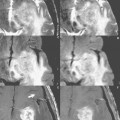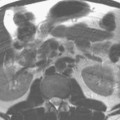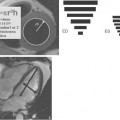56 Water Excitation, Fat Excitation
As outlined previously, the different electron environment of water-bound and fat-bound hydrogen atoms (protons) means that their respective magnetic moments precess at slightly different resonance frequencies. Specifically, the magnetic moments of hydrogen nuclei in adipose tissue have a resonance frequency that is ~3.5 ppm lower than that within water-containing tissue (which equates to ~220 Hz at 1.5 T and ~440 Hz at 3 T). A frequency-selective saturation pulse can thus be used to suppress the signal from adipose tissue. The quality of that saturation is a function of the overall magnetic field homogeneity within the imaging volume. In addition, the fat-saturating RF pulse is very close to the water resonance, leading to an overall loss in signal-to-noise ratio (SNR) at lower field strengths (where the separation is less), for example 1 T.
As an alternative to fat saturation, it is theoretically possible to simply excite either water or fat. In practice, such an approach tends to be prone to artifacts because it requires excellent field homogeneity within the volume of interest. The fundamental advantage of water excitation (over spectral fat saturation) is that the effectiveness of the fat suppression is basically immune to RF (B1) spatial inhomogeneities. This is a very important point at 3 T where RF inhomogeneities can at times be relatively severe.
Stay updated, free articles. Join our Telegram channel

Full access? Get Clinical Tree








